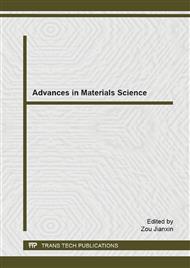p.495
p.500
p.503
p.507
p.514
p.519
p.526
p.533
p.540
Effect of Bone Composition on the Fracture Toughness of Cortical Bone
Abstract:
This study was aimed at investigating the effect of the bone compositions on the fracture toughness of bovine cortical bone. A series of the SENB bovine cortical bone specimens were tested to assess the fracture toughness. Dual energy X-ray absorptiometry (DEXA) was applied to determine the mineral content of each bovine cortical specimen and hence the porosity and bone mineral fraction were measured. Current results indicate that the mean value fracture toughness is 9.37 MNm3/2. Moreover, the fracture toughness was found to be significantly correlated with the apparent wet bone density and porosity of bone structure. No apparent correlations are found among clinical BMD and mechanical properties, implying that the BMD is an invalid indicator of the bone properties. Additionally, the tested data were fitted to the relationship, based on power law model, that the fracture toughness increase as a power (1.526) of increasing volume fraction and as a power of increasing bone mineral fraction (0.8195). These data indicate that small changes in the amount or density of compact bone tissue exert a more pronounced influence on fracture property.
Info:
Periodical:
Pages:
514-518
Citation:
Online since:
February 2015
Authors:
Keywords:
Price:
Сopyright:
© 2015 Trans Tech Publications Ltd. All Rights Reserved
Share:
Citation:


